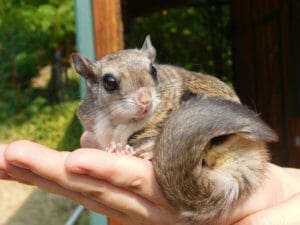
Today is Squirrel Appreciation day! Here are a couple of our favorite squirrels.
Gray Squirrel
Gray squirrels are amazing animals with adaptations that we often overlook since we see them so commonly!
• These squirrel’s trademark bushy tails help them balance while jumping from limb to limb in trees.
• Besides balance their tails are also used as an umbrella, blanket and shield from predators.
• Gray squirrels are the preppers of the animal kingdom. They work all summer to store food in secret spots which they return to in the cold and sparse winter months.
• This species’ hidden food stores help trees, flowers, and other plants with seed dispersal.
• Despite adapting well to urban living, western gray squirrels face habitat loss, predation from domestic cats, and competition from non-native species.
Our resident gray squirrel is Fredrika. She came to us in 2019 from the High Desert Museum in Bend. She was orphaned after being hit by a car. She has an injured jaw from the accident, which has caused misaligned teeth. Rodents’ teeth grow continuously throughout their entire lives and are naturally filed down. Since Fred’s injury prevents this she relies on humans to help trim her teeth so that she can eat properly.
Although Fred is different from wild squirrels in some ways, you wouldn’t know it! She is spunky and “squirrely.” She loves to stash food away and will defend her home from unknown “intruders.” Her ambassadorship is a wonderful way for people to learn about the wildlife in their own backyard!
Northern Flying Squirrel
Northern flying squirrels are also native to Southern Oregon and have their own set of adaptations.

• Northern flying squirrels are better described as “gliding squirrels” as they do not have powered flight like a bird.
• These tiny tree-dwellers use a specialized flap of skin from wrist to ankle that lets them glide downward.
• Flying squirrels are powerful jumpers and will launch themselves from tree to tree using their legs to steer and their tail as a brake.
• Though they are relatively common in the Pacific Northwest, humans rarely see them because they are nocturnal.
• Large eyes allow them to see at night and avoid predators like owls, raccoons, and foxes.
Our resident flying squirrel is Puddin’, who arrived in 2016 following a call from a local family who had been keeping her as a pet. The family had cared for her since she was found orphaned as a baby and no longer wanted her. Unfortunately, she came to us very overweight and completely imprinted on people.
Puddin’ fast became a favorite of our volunteers, staff and interns. Since she is nocturnal, Puddin’ is often found joining our Animal Care Staff on evening outreaches. When she isn’t displaying her gliders she is often cuddled up in a tiny pocket in her enclosure using her tail as a blanket.
